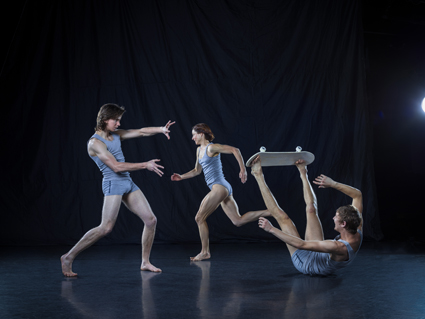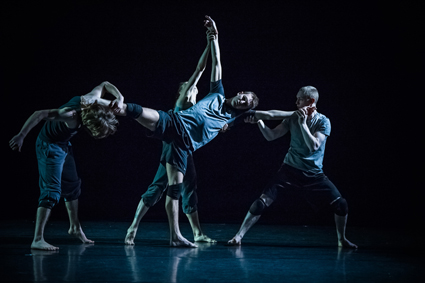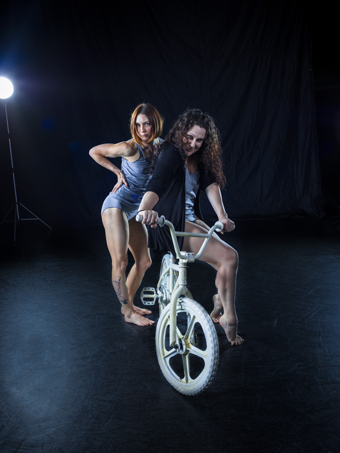 |
Tobiah Booth-Remmers, Lisa Griffiths, Lewis Rankin, Skeleton photo Chris Herzfeld, Camlight Productions |
The Editors.
ACCIDENTS APPARENTLY HAPPEN IN THREES. IN DANCER-CHOREOGRAPHER LARISSA MCGOWAN’S SKELETON, A DANCE THEATRE REVERIE-CUM-NIGHTMARE IN WHICH THE FRAGILITY OF THE HUMAN SKELETON IS SUBJECTED TO INSTRUMENTS OF POPULAR CULTURE (SKATEBOARDS, BMX BIKES, HIGH HEELS, BASEBALL BATS, ACTION FILMS AND NOISE-REDUCING HEADPHONES), ACCIDENT SCENES ARE CYCLICALLY REVISITED WITH INCREASING INTENSITY.
It’s important to point out that Skeleton is emphatically not in the same mould as, say, Branch Nebula’s Concrete and Bone Sessions (RT113); it is not built on the virtuosic manipulation of skateboards or BMX bikes. In Skeleton these and other cultural objects are rendered utterly iconic—chalk white fetishes, as they are in the works of visual artist Ricky Swallow, one of McGowan’s inspirers. As human scale black boxes-cum-screens automatically crisscross the stage they deposit these items on which we rest our gaze. First we see a skateboard, and then, in another pass, a man frozen in time, tilted forward on the board. Shortly we see him roll out, in slow motion, from a black box in a damaging tumble accompanied by the sound of an almighty crash rising out of Jethro Woodward’s dynamic, pop culture saturated score.
With other accidents we sometimes see the damage first. The performance opens with McGowan struggling, eloquently, to rise from the floor. Later we’ll see versions of the accident in a work where the order of cause and effect is not always obeyed, heightening the sense of obsessive reflection on a traumatic moment.
The images of the man and skateboard are typically punctuated by others in a world where people appear to be ephemeral and replaceable. At worst they relive their accidents. A man (Louis Rankin) wearing large white headphones, is hit violently on three different occasions by a rushing passerby. More than that, he disappears into a black box only to immediately reappear without the headphones but still locked into the same head-rolling dance of sonic possession.
A woman (Lisa Griffiths), appears, locked in muscle seizure. McGowan lifts her rigid frame and attempts to manipulate her back into shape. Later we’ll see Griffiths with the bike, folding herself, possibly lovingly, into it in various positions, one of which will become this rigor-mortised condition. We don’t need to see the moment of the accident; everything is conveyed with a grim physical poetry.
 |
Skeleton, Larrisa MacGowan photo Chris Herzfeld, Camlight Productions |
This world of gliding black boxes depositing and disappearing humans and objects is scarily fast, as is McGowan’s choreography, but there is a telling, relatively slow and sustained scene that heightens the joint themes of damage and care. To a melancholy strain from Woodrow, Tobiah Booth-Remmers rolls and shapes the rigid Griffiths with increasing aggression, as if irritated by her body’s unresponsiveness. She suddenly softens, grabs his leg; he falters and crumbles. Sitting, she creates a push/pull pieta, drawing him softly into her lap only to repel him and then draw him back. McGowan and Marcus Louend appear, duplicating this image against a cosmic hum, sharp cracks and Woodrow’s sustained melancholy half-melody (which would not have been out of place in Vangelis’ score for Bladerunner). All four struggle ineffectually to rise.
Between these darker episodes there are lighter ones which emphasise popular culture’s invitations to risk-taking and thrill-seeking—a context of perpetual danger, frequent deaths and heroic inviolability. Dancers become action heroes and villains or their bodies mutate into monstrous forms accompanied by animal roars. These are fun, amplified by the score’s plundering of soundtracks and computer gaming. But they’re not as frightening as a man swinging a baseball bat at a woman. The climax of this recurrent image has one of the men striking McGowan with the bat: shattering, it’s revealed to be a sculpted object. Here it’s the perpetrator we watch: unable to shake free the handle of the bat, so much is it a part of him, he succumbs to a mad dance of possession until finally flinging it into the upstage grid.
It’s the final stage of Skeleton where the work, after too many action scenes, achieves the thematic fruition that McGowan and co-director Sam Haren were doubtless aiming for with the completion of the ‘damage and care’ motif and now an evocation of not just the breaking of bones, but also the smashing of icons. We see the front wheel of the BMX shatter into plaster—this at last is Griffiths’ accident. The skateboard appears, shockingly, to crack of its own accord. The high heeled shoe, so delicately approached and negotiated by McGowan rolling, turning and slipping into it, crumbles beneath her. It’s as if, a la the dromology (the science or ‘logic’ of speed) of Paul Virilio, each of these instruments (they are all technologies—even the bat offers prosthetic reach) incorporates its own accident, damaging itself and its user. Louis Rankin, though, reminds us that the skeleton is likewise a piece of fragile technology as a rush of plaster pieces tumble from his t-shirt. After a final burst of violent energy the dancers, left only with the culture of fight, all fall down.
 |
Lisa Griffiths, Larissa McGowan, Skeleton photo Chris Herzfeld, Camlight Productions |
The dancers are superb, the design innovative (without being hi-tech: two stage hands manage the boxes from inside), the lighting especially deft (given the demands of the boxes) and the sound richly apt and, towards the end, much more than that. And the modelling of the objects is a delight.
What do the black screens/boxes represent beyond clever stage technology? Like the upstage wall they are neatly gridded. They move in fixed trajectories, fast and slow. They appear to be automatons. Like digital devices they deliver a ceaseless flow of images new, reworked and appropriated; like humble versions of the monolith in 2001: A Space Odyssey, they play with time and perception. As chaotic as the world of the internet can appear it nonetheless comprises often rigid networks and grids (including the machinations of corporatised popular culture) against which we act out our fragile lives and suffer their accidents.
McGowan sees Skeleton as a reflection on growing up in the 1980s with the cultural objects that possessed a generation, and their implications for the body, and presumably the psyche given that Skeleton is about more than broken bones (see interview). The design of Skeleton allows McGowan and her collaborators to replay and review, cut and paste the pleasures and traumas of youth with a three-dimensionality and physical and lo-tech immediacy still beyond the reach of digital media. The Skeleton team have made an analog machine for reflection, albeit one with all the speed and rapid cutting of its digital peers.
Dance Massive, Malthouse: Skeleton, choreographer Larissa McGowan, directors Sam Haren, Larissa McGowan, performers Tobiah Booth-Remmers, Lisa Griffiths, Marcus Louend, Larissa McGowan, Lewis Rankin, set, costume design Jonathon Oxlade, lighting Bosco Shaw, Bluebottle, composer Jethro Woodward, producer Freya Waterson, Insite Arts, Beckett Theatre, Malthouse, Melbourne, March14-23; http://dancemassive.com.au
RealTime issue #0 pg. web
© Keith Gallasch; for permission to reproduce apply to [email protected]








 back
back